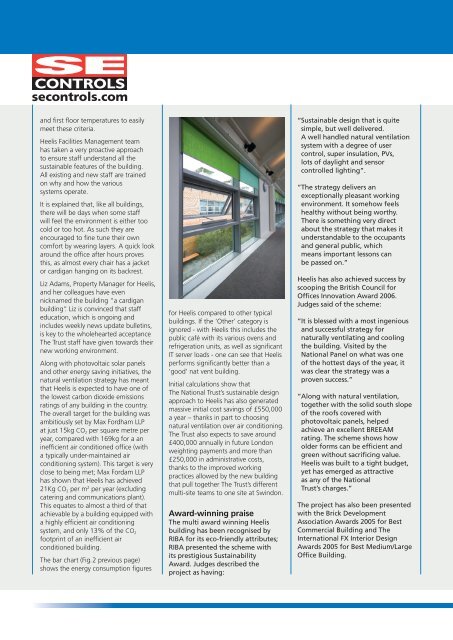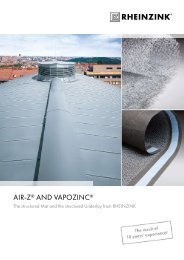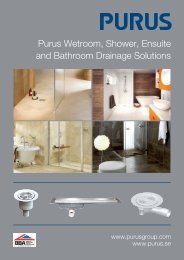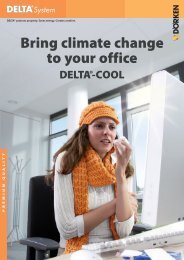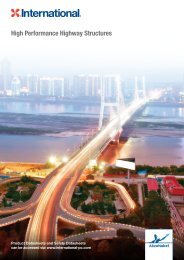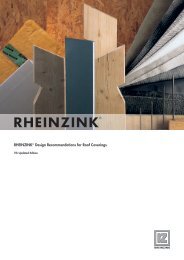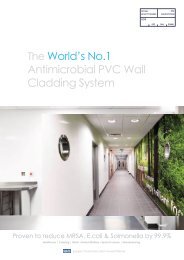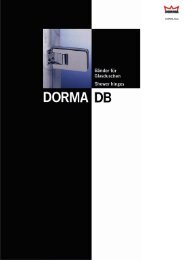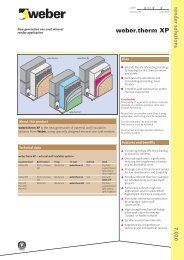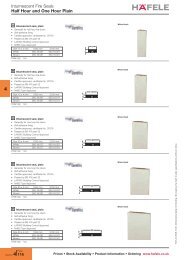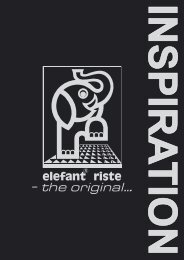Case Study: The National Trust Central Office - RIBA Product Selector
Case Study: The National Trust Central Office - RIBA Product Selector
Case Study: The National Trust Central Office - RIBA Product Selector
You also want an ePaper? Increase the reach of your titles
YUMPU automatically turns print PDFs into web optimized ePapers that Google loves.
secontrols.com<br />
and first floor temperatures to easily<br />
meet these criteria.<br />
Heelis Facilities Management team<br />
has taken a very proactive approach<br />
to ensure staff understand all the<br />
sustainable features of the building.<br />
All existing and new staff are trained<br />
on why and how the various<br />
systems operate.<br />
It is explained that, like all buildings,<br />
there will be days when some staff<br />
will feel the environment is either too<br />
cold or too hot. As such they are<br />
encouraged to fine tune their own<br />
comfort by wearing layers. A quick look<br />
around the office after hours proves<br />
this, as almost every chair has a jacket<br />
or cardigan hanging on its backrest.<br />
Liz Adams, Property Manager for Heelis,<br />
and her colleagues have even<br />
nicknamed the building “a cardigan<br />
building”. Liz is convinced that staff<br />
education, which is ongoing and<br />
includes weekly news update bulletins,<br />
is key to the wholehearted acceptance<br />
<strong>The</strong> <strong>Trust</strong> staff have given towards their<br />
new working environment.<br />
Along with photovoltaic solar panels<br />
and other energy saving initiatives, the<br />
natural ventilation strategy has meant<br />
that Heelis is expected to have one of<br />
the lowest carbon dioxide emissions<br />
ratings of any building in the country.<br />
<strong>The</strong> overall target for the building was<br />
ambitiously set by Max Fordham LLP<br />
at just 15kg CO2 per square metre per<br />
year, compared with 169kg for a an<br />
inefficient air conditioned office (with<br />
a typically under-maintained air<br />
conditioning system). This target is very<br />
close to being met; Max Fordam LLP<br />
has shown that Heelis has achieved<br />
21Kg CO2 per m2 per year (excluding<br />
catering and communications plant).<br />
This equates to almost a third of that<br />
achievable by a building equipped with<br />
a highly efficient air conditioning<br />
system, and only 13% of the CO2 footprint of an inefficient air<br />
conditioned building.<br />
<strong>The</strong> bar chart (Fig.2 previous page)<br />
shows the energy consumption figures<br />
for Heelis compared to other typical<br />
buildings. If the ‘Other’ category is<br />
ignored - with Heelis this includes the<br />
public café with its various ovens and<br />
refrigeration units, as well as significant<br />
IT server loads - one can see that Heelis<br />
performs significantly better than a<br />
‘good’ nat vent building.<br />
Initial calculations show that<br />
<strong>The</strong> <strong>National</strong> <strong>Trust</strong>’s sustainable design<br />
approach to Heelis has also generated<br />
massive initial cost savings of £550,000<br />
a year – thanks in part to choosing<br />
natural ventilation over air conditioning.<br />
<strong>The</strong> <strong>Trust</strong> also expects to save around<br />
£400,000 annually in future London<br />
weighting payments and more than<br />
£250,000 in administrative costs,<br />
thanks to the improved working<br />
practices allowed by the new building<br />
that pull together <strong>The</strong> <strong>Trust</strong>’s different<br />
multi-site teams to one site at Swindon.<br />
Award-winning praise<br />
<strong>The</strong> multi award winning Heelis<br />
building has been recognised by<br />
<strong>RIBA</strong> for its eco-friendly attributes;<br />
<strong>RIBA</strong> presented the scheme with<br />
its prestigious Sustainability<br />
Award. Judges described the<br />
project as having:<br />
“Sustainable design that is quite<br />
simple, but well delivered.<br />
A well handled natural ventilation<br />
system with a degree of user<br />
control, super insulation, PVs,<br />
lots of daylight and sensor<br />
controlled lighting”.<br />
“<strong>The</strong> strategy delivers an<br />
exceptionally pleasant working<br />
environment. It somehow feels<br />
healthy without being worthy.<br />
<strong>The</strong>re is something very direct<br />
about the strategy that makes it<br />
understandable to the occupants<br />
and general public, which<br />
means important lessons can<br />
be passed on.”<br />
Heelis has also achieved success by<br />
scooping the British Council for<br />
<strong>Office</strong>s Innovation Award 2006.<br />
Judges said of the scheme:<br />
“It is blessed with a most ingenious<br />
and successful strategy for<br />
naturally ventilating and cooling<br />
the building. Visited by the<br />
<strong>National</strong> Panel on what was one<br />
of the hottest days of the year, it<br />
was clear the strategy was a<br />
proven success.”<br />
“Along with natural ventilation,<br />
together with the solid south slope<br />
of the roofs covered with<br />
photovoltaic panels, helped<br />
achieve an excellent BREEAM<br />
rating. <strong>The</strong> scheme shows how<br />
older forms can be efficient and<br />
green without sacrificing value.<br />
Heelis was built to a tight budget,<br />
yet has emerged as attractive<br />
as any of the <strong>National</strong><br />
<strong>Trust</strong>’s charges.”<br />
<strong>The</strong> project has also been presented<br />
with the Brick Development<br />
Association Awards 2005 for Best<br />
Commercial Building and <strong>The</strong><br />
International FX Interior Design<br />
Awards 2005 for Best Medium/Large<br />
<strong>Office</strong> Building.


